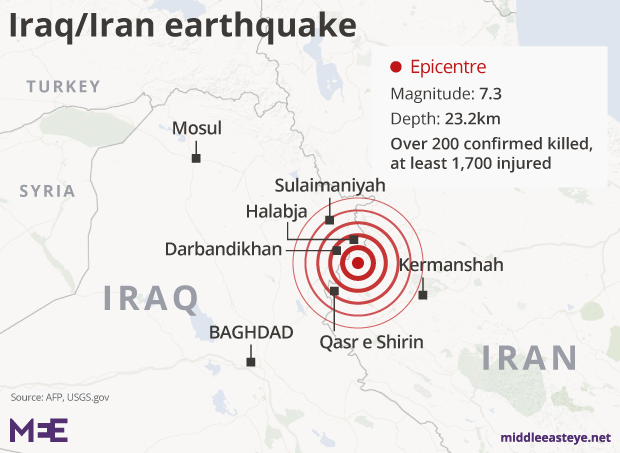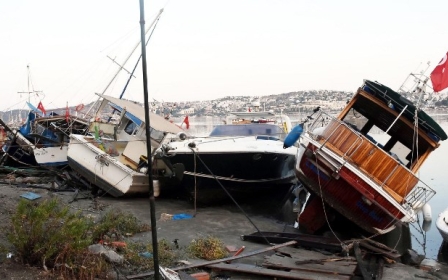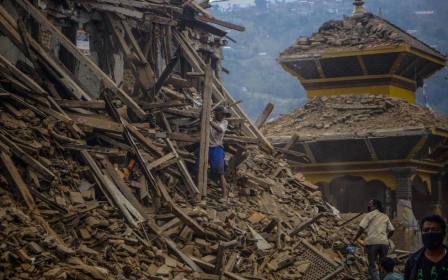Hundreds killed in strong earthquake along Iraq-Iran border
More than 300 people were killed in Iran when a magnitude 7.3 earthquake jolted the country on Sunday, state media said, and rescuers were searching for dozens trapped under rubble in the mountainous area. At least six have died in Iraq as well.
State television said more than 348 people were killed in Iran and at least 6,600 were injured. Local officials said the death toll would rise as search and rescue teams reached remote areas of Iran.
The earthquake was felt in several provinces of Iran but the hardest hit province was Kermanshah, which announced three days of mourning.
More than 142 of the victims were in Sarpol-e Zahab county in Kermanshah, about 15km from the Iraq border.
The main hospital of the capital of the county was severely damaged and could not treat hundreds of injured people who were taken there, the head of the Iranian emergency services, Pirhossein Koulivand said.
Footage posted on Twitter showed panicked people fleeing a building in Sulaimaniyah, northern Iraq, as windows shattered at the moment the quake struck late Sunday, while images from the nearby town of Darbandikhan showed major walls and concrete structures had collapsed.
IDeadly quake visits Iran & Iraq: 129 wiped out, over 1,000 injured https://t.co/1FLRpYq25p pic.twitter.com/77sqle6PPu
"We are in the process of setting up three emergency relief camps," said Mojtaba Nikkerdar, the deputy governor of Iran's Kermanshah province.
Iran is especially prone to almost daily earthquakes because it sits astride many fault lines. A magnitude 6.6 earthquake devastated the historic city of Bam in 2003, killing about 26,000 people. Many local houses there are made of mud bricks, which can crumble easily.
"Four people were killed by the earthquake" in Darbandikhan, the Iraqi town's mayor, Nasseh Moulla Hassan, told AFP. Two more people were killed in Kalar, according to the director of the hospital in the town about 70km south of Darbandikhan. At least 150 were injured, Iraqi officials said.
.#earthquake pic.twitter.com/HXOl8xtTMr
The temblor was centred 32km southwest of Halabja, Iraq, near the northeastern border with Iran, the US Geological Survey said. It struck the mountainous area of Sulaimaniyah province at 9:18pm local time (18:18 GMT) at a depth of 33.9km, the monitor said.
It was felt for about 20 seconds in Baghdad, and sometimes for longer in other provinces of Iraq.
In the province of Sulaimaniyah, located in Iraq's Kurdistan region, residents ran out onto the streets at the time of the quake and some property damage was recorded, an AFP reporter said.
In Iran, the ISNA news agency said that the earthquake was felt in several cities in the west of the country including Tabriz.
Iranian state television said the quake was felt in numerous cities in the country and had damaged eight villages, including knocking out electricity in many of them.
The semi-official Iranian ILNA news agency reported that at least 14 provinces had been impacted by the earthquake.
Iranian social media was abuzz with posts of people evacuating their homes, especially from the cities of Ghasr-e Shirin - near the Iraqi border - and Kermanshah, the Guardian reported.
Esmail Najar, head of Iran's National Disaster Management Organisation, said: “Some injured people might be buried under the rubble in Ghasr-e Shirin.”
Iran's emergency services chief Pirhossein Koolivand said it was "difficult to send rescue teams to the villages because the roads have been cut off... there have been landslides".
It added that 30 aid teams had been sent to the quake zone, parts of which had experienced power cuts.
In southeastern Turkey, the earthquake was felt "from Malatya to Van", an AFP correspondent said. In the town of Diyarbakir, residents also left their homes before returning.
New MEE newsletter: Jerusalem Dispatch
Sign up to get the latest insights and analysis on Israel-Palestine, alongside Turkey Unpacked and other MEE newsletters
Middle East Eye delivers independent and unrivalled coverage and analysis of the Middle East, North Africa and beyond. To learn more about republishing this content and the associated fees, please fill out this form. More about MEE can be found here.





